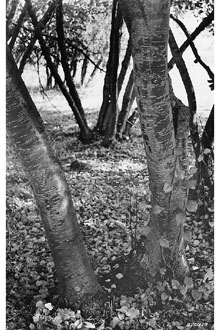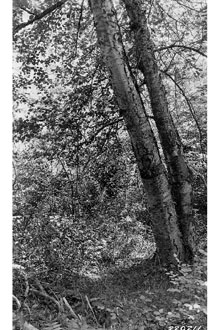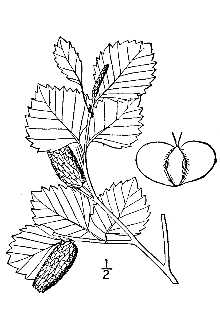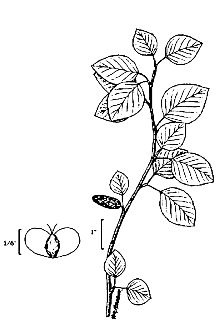Betula papyrifera Marshall var. occidentalis (Hook.) Sarg.
Scientific Name: Betula papyrifera Marshall var. occidentalis (Hook.) Sarg.
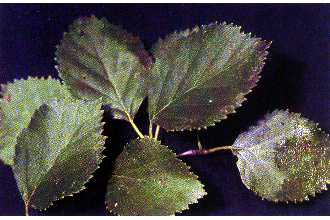
| General Information | |
|---|---|
| Usda Symbol | BEPAO2 |
| Group | Dicot |
| Life Cycle | Perennial |
| Growth Habits | ShrubTree, |
| Native Locations | BEPAO2 |
Plant Guide
Alternative Names
Rocky Mountain birch, mountain birch, red birch, black birch, spring birch
Uses
Economic: The wood is hard and heavy and is used for firewood and fence posts (Hosie 1969). Wildlife: Goats, sheep, mule deer, and elk browse Water birch. Beavers harvest the stems of water birch to aid in their construction of dams and lodges. The broad-tailed hummingbird and red-napped sapsucker feed on sap oozing from holes in the bark made by sapsuckers (Gullion 1964). Agroforestry: Water birch is used in forested riparian buffers to help reduce stream bank erosion, protect aquatic environments, enhance wildlife, and increase biodiversity.
Description
General: Birch family (Betulaceae). Water birch (Betula occidentalis) is a small native tree or shrub that grows in clusters along the banks of streams and lakes. The leaves are thin, ovate, rather coarsely toothed and are usually 1-2 inches long. The fruit is tiny hairy nutlets with wings broader than the seed. The bark is thin, dark reddish-brown to black, with mark horizontal slits, and does not peel like other birches. Distribution: White birch is distributed from southern Manitoba to southern Alaska and North Dakota and south to California and New Mexico. For current distribution, please consult the Plant profile page for this species on the PLANTS Web site. R. Mohlenbrock USDA, NRCS, Wetland Science Institute @ PLANTS
Adaptation
Betula occidentalis is very shade tolerant. It is mostly found in wet to moist nutrient-rich soils, along streams, in mountain canyons, usually in coniferous forest (Little 1980). Water birch occurs on a wide variety of soil textures generally at low to middle elevations.
Establishment
Propagation from Seed: Seeds may be collected from local trees for establishing nursery stock. Sow the seeds as soon as they are ripe in containers or seed trays containing a slow-release fertilized. Firm the medium and sow the seeds thinly and evenly on top, and lightly cover with medium. Once the seedlings are large enough to handle they should be placed into individual pots. Once seedlings are 18-30 inches tall remove from individual pots and outplant to premature location.
Management
Nursery grown seedlings should be planted onto moist sites. The seedlings should be transplanted when they are one to two years old. The best time for transplanting is in the spring as the buds begin to turn green. Cultivars, Improved and Selected Materials (and area of origin) Contact your local Natural Resources
Conservation
Service (formerly Soil Conservation Service) office for more information. Look in the phone book under ”United States Government”. The Natural Resources Conservation Service will be listed under the subheading “Department of Agriculture.”
References
Arno, S,F, 1977, Northwest trees, The Mountaineers, Seattle, Washington, Brinkman, K,A, 1974, Seeds of wood plants in the United States, USDA Agriculture Handbook 450, Washington, D,C, Dirr, M,A, 1990, Manual of woody landscape plants: their identification, ornamental characteristics, culture, propagation, and uses, Stibes Publishing Company, Champaign, Illinois, Gullion, G,W, 1964, Wildlife uses of Nevada plants, Contributions toward a Flora of Nevada No, 49, Beltsville, Maryland, Heuser, C,W, 1997, The complete book of plant propagation, The Taunton Press, Newtown, Connecticut, Hosie, R,C, 1969, Native trees of Canada, 7th ed, Ottawa, Ontario, Canada, Lanner, R,M, 1983, Shrubs of the Great Basin: A Natural History, University of Nevada Press, Reno, Nevada, Little, E,L, 1980, National Audubon Society field guide to North American trees: western region, Alfred A, Knopf Inc,, New York, New York, Munz, P,A, 1965, A California flora, University of California Press, Berkely and Los Angeles, California, Use soil moisture sensors to measure the soil moisture of Betula papyrifera Marshall var. occidentalis (Hook.) Sarg.., Nelson, R,A, 1992, Handbook of Rocky Mountain plants, Roberts Rinehart Publishers, Niwot, Colorado, Sargent, C,S, 1922, Manual of the trees of North America, Vol, 1, Dover Publications, Inc,, New York, New York, Van Dersal, W,R, 1938, Native woody plants of the United States, their erosion-control and wildlife values, Washington, D,C,
Plant Traits
Growth Requirements
| Temperature, Minimum (°F) | -62 |
|---|---|
| Adapted to Coarse Textured Soils | Yes |
| Adapted to Fine Textured Soils | Yes |
| Adapted to Medium Textured Soils | Yes |
| Anaerobic Tolerance | Medium |
| CaCO3 Tolerance | Low |
| Cold Stratification Required | No |
| Drought Tolerance | Low |
| Fertility Requirement | Medium |
| Fire Tolerance | High |
| Frost Free Days, Minimum | 140 |
| Hedge Tolerance | None |
| Moisture Use | High |
| pH, Maximum | 7.8 |
| pH, Minimum | 5.5 |
| Planting Density per Acre, Maxim | 700 |
| Planting Density per Acre, Minim | 300 |
| Precipitation, Maximum | 70 |
| Precipitation, Minimum | 10 |
| Root Depth, Minimum (inches) | 20 |
| Salinity Tolerance | None |
| Shade Tolerance | Intermediate |
Morphology/Physiology
| Bloat | None |
|---|---|
| Toxicity | None |
| Resprout Ability | Yes |
| Shape and Orientation | Erect |
| Active Growth Period | Spring and Summer |
| C:N Ratio | Medium |
| Coppice Potential | No |
| Fall Conspicuous | No |
| Fire Resistant | No |
| Flower Color | Yellow |
| Flower Conspicuous | No |
| Foliage Color | Green |
| Foliage Porosity Summer | Moderate |
| Foliage Porosity Winter | Porous |
| Foliage Texture | Medium |
| Fruit/Seed Conspicuous | No |
| Nitrogen Fixation | None |
| Low Growing Grass | No |
| Lifespan | Short |
| Leaf Retention | No |
| Known Allelopath | No |
| Height, Mature (feet) | 25.0 |
| Height at 20 Years, Maximum (fee | 25 |
| Growth Rate | Rapid |
| Growth Form | Multiple Stem |
| Fruit/Seed Color | Brown |
Reproduction
| Vegetative Spread Rate | None |
|---|---|
| Small Grain | No |
| Seedling Vigor | Medium |
| Seed Spread Rate | Slow |
| Fruit/Seed Period End | Spring |
| Seed per Pound | 402000 |
| Propagated by Tubers | No |
| Propagated by Sprigs | No |
| Propagated by Sod | No |
| Propagated by Seed | Yes |
| Propagated by Corm | No |
| Propagated by Container | Yes |
| Propagated by Bulb | No |
| Propagated by Bare Root | Yes |
| Fruit/Seed Persistence | No |
| Fruit/Seed Period Begin | Spring |
| Fruit/Seed Abundance | Medium |
| Commercial Availability | Routinely Available |
| Bloom Period | Mid Spring |
| Propagated by Cuttings | No |
Suitability/Use
| Veneer Product | No |
|---|---|
| Pulpwood Product | No |
| Post Product | Yes |
| Palatable Human | No |
| Palatable Graze Animal | Low |
| Palatable Browse Animal | Medium |
| Nursery Stock Product | No |
| Naval Store Product | No |
| Lumber Product | No |
| Fuelwood Product | Medium |
| Fodder Product | No |
| Christmas Tree Product | No |
| Berry/Nut/Seed Product | No |
